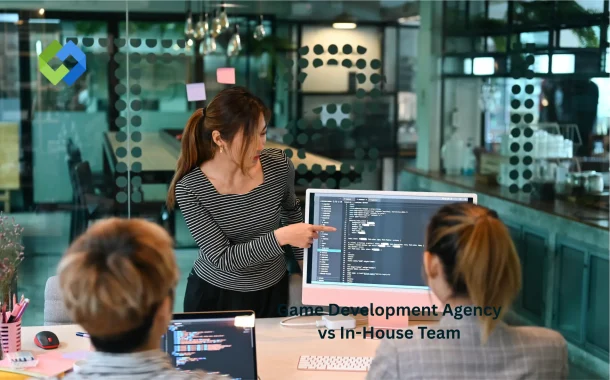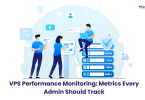This is the part where creative notes become task lists, and where every studio, no matter the size, faces the same fundamental question: how will the development actually happen?
Do you hire your own team and grow it internally? Do you bring in outside help for certain pieces like art or QA? Or do you hand the full production to a game development agency that already has the people and the pipeline to do it?
Each option makes sense in different situations. The trick is figuring out which one fits your project, your timeline, and your budget. Let’s break down how these approaches actually play out in practice.
Table of Contents
Table of Contents
What Building Your Own Team Actually Looks Like
Building an in-house team means hiring game developers across multiple disciplines — programmers familiar with your engine, artists who can match the desired visual style, designers who understand the genre, producers to keep workflows on track, and QA specialists to handle inevitable bugs.
For a mid-sized project, this typically requires 15–30 people at minimum, possibly more depending on scope and ambition.
Recruitment is the first major challenge. Experienced developers often receive multiple offers, and specialists with specific backgrounds — for example, someone who has shipped a console-based multiplayer shooter — are rarely available for long. Filling key roles can take several months, especially outside major tech hubs.
After hiring, there’s an adaptation period. New team members must learn the codebase, tools, and internal workflows. Even highly experienced professionals need a few weeks before they reach full productivity.
The benefits, however, can justify the investment. Direct communication enables faster decision-making. Cultural alignment grows naturally when people collaborate daily. Once a project is complete, the same team is already synchronized for future development.
But the costs are substantial. A senior engineer in the U.S. typically costs $150,000–$200,000 annually when factoring in benefits, taxes, equipment, and overhead. Junior developers are less expensive but require mentoring, which takes time from senior staff. Multiply that across the team, and budgets expand quickly.
Scaling also brings challenges. Need three more environment artists for Q3? Recruitment has to start in Q1. When production slows, studios face a difficult choice: maintain salaries during downtime or initiate layoffs — both of which affect morale and future hiring potential.
Specialized skills present another dilemma. Suppose advanced shader programming is needed for just two months of work. Hiring a full-time specialist isn’t practical, and assigning the task to an existing graphics programmer could lead to delays and costly trial-and-error.
How Development Agencies Actually Work
A game development company isn’t structured like a classic game studio. Instead of keeping huge teams on payroll, they work with groups of specialists they can bring in when a project needs them. Clients negotiate a contract, the agency allocates the right people, and production begins.
Some agencies handle the whole journey, from the first pitch to the final build. Others narrow in on specific tasks like art outsourcing, mobile ports, or QA. Many studios today choose to collaborate with a trusted game development agency that provides production flexibility without the long-term costs of permanent staff.
It’s a flexible model, and that’s why a lot of teams use agencies as an extension of their own production pipeline rather than trying to scale up internally every time.
Five Agencies Worth Knowing About
- Kevuru Games (Ukraine) handles everything from mobile titles to VR projects, working in both Unity and Unreal. The studio has shipped games across multiple platforms, offering pricing significantly lower than teams based in California or London. Their development team structure is notably flexible — clients can bring on a single technical artist to solve a specific issue or scale up to a full production crew for months-long projects. Some partners treat them as an extension of their own teams for ongoing collaborations.
- Virtuos, one of the largest external development companies in Asia, operates studios in Singapore, China, Vietnam, and other locations. The company has contributed to major titles such as The Last of Us Part II, Horizon Forbidden West, and Final Fantasy VII Remake. Its core strength lies in scale and reliability: when thousands of optimized assets with strict technical requirements are needed, Virtuos can deliver efficiently and consistently.
- Magic Media, headquartered in the UK and Spain, focuses on projects that require strong art direction and cohesive storytelling. The studio provides concept development, cinematics, and character design services. It’s particularly suited for narrative-driven games or productions seeking a distinctive visual identity rather than just high-volume asset output.
- Argentics, based in Argentina, specializes in art — 2D, 3D, UI, and concept work. Their time zone aligns well with North American clients, and they’re known for reasonable rates and fast delivery. Argentics is a strong choice for studios that need steady art production capacity without the commitment of full-time hires.
- Streamline Media Group, with offices in Amsterdam and Malaysia, has contributed to over 200 titles including Mortal Kombat, Assassin’s Creed, and Gears of War. The company focuses on large-scale asset production — environments, characters, props, and weapons — providing industrial-grade capacity for demanding AAA pipelines.
Why This Model Works
The primary advantage of game development outsourcing is speed. Projects can begin within weeks rather than months. There are no job postings, interviews, or onboarding delays — agencies assign specialists who already understand the necessary tools and production workflows.
Budget control also becomes more predictable. Payment is tied to deliverables, not fixed salaries. When production slows, costs decrease; when scaling up is required, the contract simply adjusts.
Access to specialized talent is another major benefit. Experts in procedural generation, advanced shaders, or optimization are often already part of the agency’s network. They bring proven solutions from previous projects instead of learning at your expense, accelerating progress and reducing risk.
Where It Gets Complicated
Working with an external team is helpful, but it’s not frictionless. You don’t get the same level of hands-on control you have with an in-house crew. Agency teams often juggle several projects, so something urgent might take a bit longer than expected.
Communication works differently too. You can’t just lean over someone’s desk to clarify a feature. Everything happens through messages or calls, and sometimes a small misunderstanding can slow things down.
Because of that, good project management becomes the backbone of the partnership. Clear briefs, regular check-ins, and direct feedback matter a lot. Broad comments like “this should feel nicer” don’t translate well when teams are in different time zones and working through structured pipelines.
And of course there’s the trust factor. Handing part of your game to an outside group always feels a little risky at first. Reputable agencies deal with this through NDAs, security processes, and open workflows, but real trust still builds only after working together for a while.
Managing External Teams
Collaborating with an external agency changes how a studio operates day to day. Most modern studios use a hybrid structure: internal leads define creative vision and priorities, while agency specialists execute clearly scoped tasks. This model keeps direction centralized but adds flexibility where production tends to bottleneck — in asset creation, level design, or technical art.
The tool stack becomes your shared workspace. Jira or Linear track progress, Confluence or Notion capture evolving documentation, and Slack or Discord replace the hallway conversations that once solved problems in minutes. The key difference is intent — everything must be written down clearly enough for someone five time zones away to act on it without a follow-up call.
Interestingly, well-established agencies often bring a level of operational discipline that smaller studios rarely have time to develop. Their pipelines have been pressure-tested across dozens of projects. Their QA processes are structured and repeatable. Their asset-naming conventions actually make sense. In many cases, the studio ends up borrowing these systems long after the contract ends — a quiet but valuable form of knowledge transfer that improves how internal teams work too.
Defining milestones precisely is vital. A target like “Deliver 50 hero characters by the end of Sprint 6 — maximum 40K triangles, PBR materials, fully rigged and weighted” is actionable. In contrast, “Make the characters look cool” is not. The discipline of setting clear, measurable goals often improves outcomes more than solving any single technical challenge.
Direct Comparison
| Factor | Agency | In-House |
| Time to start | Days to weeks | Months |
| Cost structure | Pay for work delivered | Fixed salaries + benefits + overhead |
| Specialist access | Broad range available | Limited to current hiring market |
| Scaling | Adjust quickly | Slow, requires HR process |
| Communication | Requires structure | Naturally fluid |
| Control | Managed through tools | Direct daily oversight |
| Knowledge retention | Ends with contract | Stays with team |
When Each Makes Sense
Agencies are ideal when specialized expertise is needed for a defined period — such as a mobile port requiring platform-specific knowledge, an art sprint to expand an asset library, or a short-term prototype to validate a concept before full production. They also work well for testing ideas or building vertical slices without long-term commitments.
In-house teams make more sense for long-term projects, particularly live-service games that require continuous updates and maintenance. If intellectual property is highly sensitive or competitive advantage depends on company culture, keeping production internal ensures greater control and security. When funding is stable and hiring cycles can be absorbed, the investment in permanent staff ultimately pays off.
Most successful studios combine both approaches. Core teams — lead designers, senior engineers, producers — remain in-house, while execution-heavy tasks such as asset production, QA testing, porting, or localization are outsourced.
CD Projekt Red, for instance, developed most of The Witcher 3 internally but partnered with external studios for specific components. Epic Games keeps Unreal Engine development in-house while collaborating widely on Fortnite content. Even smaller studios like Supergiant maintain compact internal teams and bring in specialists when necessary.
The Hybrid Reality
The industry is increasingly moving away from purely internal or external structures. Modern studios maintain permanent staff for leadership and creative direction, then scale capacity through agency partnerships and freelancers.
This approach demands mature production management. Producers must define clear specifications. Technical directors need the ability to evaluate external code quality. Art directors should provide actionable, detailed feedback rather than broad creative notes.
Studios that succeed with this model stop viewing external collaboration as “us versus them.” Instead, they focus on “the right people, at the right time, for the right cost.” They implement project management models designed for distributed teams and treat external partners as genuine extensions of their studio rather than as vendors to micromanage.
Actually Making the Decision
For a long-term, two-year live-service project, building internal infrastructure is usually the best choice. For rapid prototyping or market testing, collaborating with an agency offers greater flexibility and speed. Most projects, however, fall somewhere in between.
Studios that consistently deliver successful games aren’t necessarily those with the largest teams — they’re the ones that deploy talent strategically and manage production effectively.
In the end, players only care about whether the game is good — not how it was produced. The choice between in-house and agency models, project management frameworks, and hiring strategies are all matters of production logistics. Important ones, yes, but ultimately secondary to a single question: are you building something people want to play?














